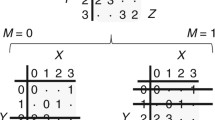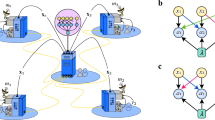Abstract
Can quantum communication be more efficient than its classical counterpart? Holevo's theorem rules out the possibility of communicating more than n bits of classical information by the transmission of n quantum bits—unless the two parties are entangled, in which case twice as many classical bits can be communicated but no more. In apparent contradiction, there are distributed computational tasks for which quantum communication cannot be simulated efficiently by classical means. In some cases, the effect of transmitting quantum bits cannot be achieved classically short of transmitting an exponentially larger number of bits. In a similar vein, can entanglement be used to save on classical communication? It is well known that entanglement on its own is useless for the transmission of information. Yet, there are distributed tasks that cannot be accomplished at all in a classical world when communication is not allowed, but that become possible if the non-communicating parties share prior entanglement. This leads to the question of how expensive it is, in terms of classical communication, to provide an exact simulation of the spooky power of entanglement.
Similar content being viewed by others
References
S. Aaronson and A. Ambainis, “Quantum search of spatial regions”, Proceedings of 44th Annual IEEE Symposium on Foundations of Computer Science, to appear (2003).
H. Abelson, “Lower bounds on information transfer in distributed computations”, Proceedings of 19th Annual IEEE Symposium on Foundations of Computer Science, pp. 151–158 (1978).
M. Aigner and G. M. Ziegler, Proofs from THE BOOK (Springer, 1998).
A. Ambainis, “Communication complexity in a 3-computer model”, Algorithmica 16(3), 298–301 (1996).
D. Bacon and B. F. Toner, “Bell inequalities with auxiliary communication”, Phys. Rev. Lett. 90, 157904(2003).
J. S. Bell, “On the Einstein–Podolsky–Rosen paradox”, Physics 1, 195–200 (1964).
C. H. Bennett and G. Brassard, “Quantum cryptography: Public key distribution and coin tossing”, Proceedings of IEEE International Conference on Computers, Systems and Signal Processing, Bangalore, India, pp. 175–179 (1984).
C. H. Bennett, G. Brassard, C. Crépeau, R. Jozsa, A. Peres, and W. K. Wootters, “Teleporting an unknown quantum state via dual classical and Einstein–Podolsky–Rosen channels”, Phys. Rev. Lett. 70(13), 1895–1899 (1993).
C. H. Bennett, G. Brassard, and A. K. Ekert, “Quantum cryptography”, Scientific American, 50–57 (October 1992).
C. H. Bennett, G. Brassard, S. Popescu, B. Schumacher, J. A. Smolin and W. K. Wootters, “Purification of noisy entanglement and faithful teleportation via noisy channels, ” Phys. Rev. Lett. 76(5), 722–725 (1996).
C. H. Bennett and S. J. Wiesner, “Communication via one-and two-particle operators on Einstein–Podolsky–Rosen states”, Phys. Rev. Lett. 69(20), 2881–2884 (1992).
A. Berthiaume and G. Brassard, “Oracle quantum computing”, J. Mod. Optics 41(12), 2521–2535 (1994).
G. Brassard, “Quantum communication complexity (a survey)”, Proceedings of NATO Workshop on Decoherence and its Implications in Quantum Computing and Information Transfer, Mykonos, Greece, pp. 199–210 (2000).
G. Brassard, A. Broadbent, and A. Tapp, “Multi-party pseudo-telepathy”, Proceedings of Workshop on Algorithms and Data Structures, to appear (2003).
G. Brassard, R. Cleve, and A. Tapp, “Cost of exactly simulating quantum entanglement with classical communication”, Phys. Rev. Lett. 83(9), 1874–1877 (1999). Originally posted as arXiv:quant-ph/9901035 (January 1999).
H. Buhrman, “Quantum computing and communication complexity”, EATCS Bulletin 70, 131–141 (2000).
H. Buhrman, R. Cleve, and W. van Dam, “Quantum entanglement and communication complexity”, SIAM J. Comp. 30(6), 1829–1841 (2001). Originally posted as arXiv: quant-ph/9705033 (May 1997).
H. Buhrman, R. Cleve, J. Watrous, and R. de Wolf, “Quantum fingerprinting”, Phys. Rev. Lett. 87(16), article 167902(2001).
H. Buhrman, R. Cleve, and A. Wigderson, “Quantum vs. classical communication and computation”, Proceedings of 30th Annual ACM Symposium on Theory of Computing, pp. 63–68 (1998).
H. Buhrman, W. van Dam, P. Høyer, and A. Tapp, “Multiparty quantum communication complexity”, Phys. Rev. A 60(4), 2737–2741 (1999). Originally posted as arXiv:quant-ph/9710054 (October 1997).
H. Buhrman and R. de Wolf, “Communication complexity lower bounds by polynomials”, Proceedings of 16th IEEE Conference on Computational Complexity, pp. 120–130 (2001).
N. Cerf, N. Gisin, and S. Massar, “Classical teleportation of a quantum bit”, Phys. Rev. Lett. 84(11), 2521–2524 (2000).
R. Cleve and H. Buhrman, “Substituting quantum entanglement for communication”, Phys. Rev. A 56(2), 1201–1204 (1997). Originally posted as arXiv:quant-ph/9704026 (April 1997).
R. Cleve, W. van Dam, M. Nielsen, and A. Tapp, “Quantum entanglement and the communication complexity of the inner product function”, Quantum Computing and Quantum Communication: Proceedings of First NASA International Conference (QCQC'98), Lecture Notes in Computer Science, Vol. 1509 (Springer, 1999), pp. 61–74. Originally posted as arXiv:quant-ph/9708019 (August 1997).
D. Deutsch and R. Jozsa, “Rapid solution of problems by quantum computation”, Proc. Roy. Soc. Lond. Ser. A 439, 553–558 (1992).
P. Frankl and V. Rödl, “Forbidden intersections”, Trans. Am. Math. Soc. 300(1), 259–286 (1987).
V. Galliard, A. Tapp, and S. Wolf, “The impossibility of pseudo-telepathy without quantum entanglement”, Proceedings of IEEE International Symposium on Information Theory, p. 457(2003).
V. Galliard and S. Wolf, “Pseudo-telepathy, entanglement, and graph colorings, ” Proceedings of IEEE International Symposium on Information Theory, p. 101(2002).
N. Gisin and B. Gisin, “A local hidden variable model of quantum correlation exploiting the detection loophole”, Phys. Lett. A 260, 323–327 (1999).
D. M. Greenberger, M. Horne, and A. Zeilinger, “Going beyond Bell's theorem”, in Bell's Theorem, Quantum Theory, and Conceptions of the Universe, M. Kafatos, ed. (Kluwer Academic, Dordrecht, 1989), pp. 69–72.
L. K. Grover, “Quantum mechanics helps in searching for a needle in a haystack”, Phys. Rev. Lett. 79(2), 325–328 (1997).
L. K. Grover, “Quantum telecomputation”, available as arXiv: quant-ph/9704012 (April 1997).
L. Hardy, “Quantum mechanics, local realistic theories, and Lorentz-invariant realistic theories, ” Phys. Rev. Lett. 68(20), 2981–2984 (1992).
A. Holevo, “Bounds for the quantity of information transmitted by a quantum communication channel”, Problemy Peredachi Informatsii 9, 3–11 (1973). English translation in Problems of Information Transmission 9, 177–183 (1973).
P. Høyer and R. de Wolf, “Improved quantum communication complexity bounds for disjointness and equality”, Proceedings of 19th Annual Symposium on Theoretical Aspects of Computer Science, Lecture Notes in Computer Science, Vol. 2285 (Springer, 2002), pp. 299–310.
B. Kalyanasundaram and G. Schnitger, “The probabilistic communication complexity of set intersection”, Proceedings of 2nd Annual IEEE Conference on Structure in Complexity Theory, pp. 41–47 (1987).
H. Klauck, “Quantum communication complexity”, Proceedings of Workshop on Boolean Functions and Applications at 27th International Colloquium on Automata, Languages and Programming, pp. 241–252 (2000). Also available as arXiv:quant-ph/0005032 (May 2000).
H. Klauck, “On quantum and probabilistic communication: Las Vegas and one-way protocols”, Proceedings of 32nd Annual ACM Symposium on Theory of Computing, pp. 644–651 (2000).
H. Klauck, “One-way communication complexity and the Nečiporuk lower bound on formula size”, available as arXiv:cs.CC/0111062 (November 2001).
I. Kremer, Quantum Communication, Master's thesis, Hebrew University, Computer Science Department, 1995.
E. Kushilevitz and N. Nisan, Communication Complexity (Cambridge University Press, Cambridge, 1997).
S. Massar, D. Bacon, N. Cerf, and R. Cleve, “Classical simulation of quantum entanglement without local hidden variables”, Phys. Rev. A 63(5), article 052305(2001).
T. Maudlin, “Bell's inequality, information transmission, and prism models, ” in PSA 1992, Vol. 1, D. Hull, M. Forbes, and K. Okruhlik, eds. (Philosophy of Science Association, East Lansing, 1992), pp. 404–417.
N. D. Mermin, “What's wrong with these elements of reality?”, Physics Today 43, 9–11 (1990).
N. D. Mermin, “Quantum mysteries revisited”, Am. J. Phys. 58, 731–734 (1990).
I. Newman, “Private vs. common random bits in communication complexity”, Information Processing Letters 39(2), 67–71 (1991).
I. Newman and M. Szegedy, “Public vs. private coin flips in one round communication games”, Proceedings of 28th Annual ACM Symposium on Theory of Computing, pp. 561–570 (1996).
R. Raz, “Exponential separation of quantum and classical communication complexity”, Proceedings of 31st Annual ACM Symposium on Theory of Computing, pp. 358–367 (1999).
A. A. Razborov, “Quantum communication complexity of symmetric predicates”, (in Russian), Izvestiya of the Russian Academy of Science, Mathematics 67(1), 159–176 (2003). Available in English as arXiv:quant-ph/0204025 (April 2002).
P. W. Shor, “Polynomial-time algorithms for prime factorization and discrete logarithms on a quantum computer”, SIAM J. Comp. 26, 1484–1509 (1997).
M. Steiner, “Towards quantifying non-local information transfer: Finite-bit non-locality”, Phys. Lett. A 270(5), 239–244 (2000). Originally posted as arXiv:quant-ph/9902014 (February 1999).
A. Ta-Shma, “Classical versus quantum communication complexity”, ACM Sigact News 30(3), 25–34 (1999).
B. F. Toner and D. Bacon, “The communication cost of simulating Bell correlations”, available as arXiv:quant-ph/0304076 (April 2003).
R. F. Werner, “Quantum states with Einstein–Podolsky–Rosen correlations admitting a hidden-variable model”, Phys. Rev. A 40(8), 4277–4281 (1989).
R. de Wolf, “Quantum communication and complexity”, Theoretical Computer Science 287(1), 337–353 (2002).
A. C.-C. Yao, “Some complexity questions related to distributive computing”, Proceedings of 11th Annual ACM Symposium on Theory of Computing, pp. 209–213 (1979).
A. C.-C. Yao, “Quantum circuit complexity”, Proceedings of 34th Annual IEEE Symposium on Foundations of Computer Science, pp. 352–361 (1993).
N. D. Mermin, “Extreme quantum entanglement in a superposition of macroscopically distinct states”, Phys. Rev. Lett. 65, pp. 1838–1840 (1990).
Author information
Authors and Affiliations
Rights and permissions
About this article
Cite this article
Brassard, G. Quantum Communication Complexity. Foundations of Physics 33, 1593–1616 (2003). https://doi.org/10.1023/A:1026009100467
Issue Date:
DOI: https://doi.org/10.1023/A:1026009100467




